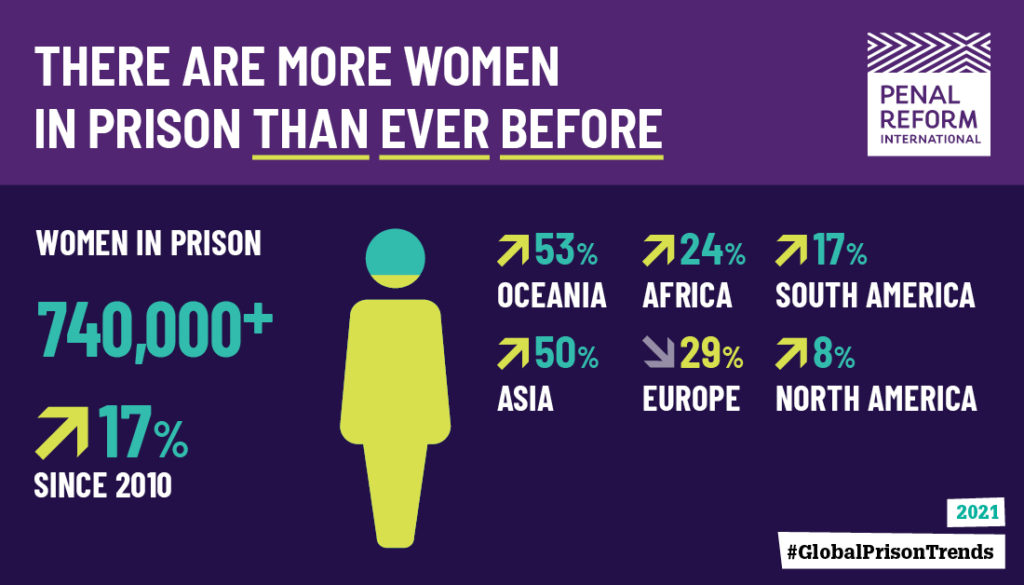
Penal Reform International and the Thailand Institute of Justice released Global Prison Trends 2022. While not particularly surprising, it is still a sobering read. First, the global prison population is at an all-time high; 11.5 million people are currently reported as incarcerated. It must be recalled that many countries don’t gather data on prison populations, and other refuse to make public the data they have. 121 countries report prisons above official capacity … in the middle, still, of a highly contagious pandemic. 33% of incarcerated people are awaiting trial, innocent until something or other. Overall, the prison population has risen 24% since 2000. Women are the center of that catastrophic rise: “The number of women in prison has increased 33% over the past 20 years, compared to a 25% rise among men.” Where are the women?
What accounts for the rate of women’s incarceration? The short, and long, answer is patriarchy, misogyny. Women are particularly targeted by the ongoing so-called War on Drugs, especially across Latin America, as well as India, Indonesia, Kenya, Russia, South Africa and Uganda. While women make up a small fraction of people currently on death row, the vast majority are on death row for drug offenses. In Malaysia, for example, 90% of the women on death row were convicted of a drug offense, compared to 70% of the men. Women are also particularly targeted by laws that criminalize poverty and status. For example, 42 African countries criminalize people with no fixed address or means of subsistence. Petty survival theft is treated as a major felony. Women have been arrested for taking discarded food from restaurant trash receptacles.
Globally, the use of formal life imprisonment sentences has increased. In the United States, for example, since 2008, the number of women serving life imprisonment without the possibility of parole has increased 43%. In the United States, one of every fifteen incarcerated women is serving a life sentence, up 19% over thirteen years. Where are the women? In prison, for life.
Globally, the situation for indigenous women has worsened. In Canada, 48% of incarcerated women are Native women. In New Zealand, 60% of incarcerated women are Māori and Pacific women. In New Zealand prisons, Māori women make up as much as almost 80% of those sent into solitary. Further, still in New Zealand, Māori and Pacific women make up 93% of women segregated for 15 days or longer. Where are the indigenous women? In solitary.
Over 740,000 women are in prison. Increasingly, those women are in for longer and longer sentences. Over the past three decades, the number of women serving an indeterminate sentence in England and Wales has increased by 241%. In country after country, women serving life sentences, or sentences that might as well be life sentences, are living with trauma, abuse, violence. Those histories are seldom considered, and the prisons have little to no appropriate health or healing services. `Status offense’ laws – abortion, adultery, sexwork – target increasing numbers of women.
Reproductive health is practically nonexistent for incarcerated women, although eleven countries have passed laws to prohibit the incarceration of pregnant women. Incarcerated women disproportionately live with mental health issues. For example, in England Wales, 70% of incarcerated women, and 48% of incarcerated men, live with mental health `problems’. Self harm and suicide are rampant among incarcerated women. More incarcerated women live with HIV than incarcerated men. According to UNAIDS, in 2020, the average HIV prevalence among women in prison was 5.2%, for men 2.9%.
Globally, prisons are increasingly and more intensely overcrowded. Although women are the fastest growing prison population, they are still the minority. This means they have least access to water and to sanitation. Little drinking water, no toilets, broken toilets are commonplace for incarcerated women.
The global prison population has reached an all-time high. Women are the fastest growing prison population, still and again: Low-income women, Indigenous and Aboriginal women, women of color, minority women, LGBTIQ+ women, elder women, younger women, homeless women, shackdweller women, women living with trauma, women survivors of violence, and so many other women. Nation-states have invested heavily in this program and continue to do so. Last year, at least 21 countries announced their plans to build more prisons. Alabama announced it will use Covid relief funds to build a new women’s prison. The struggle continues.
(By Dan Moshenberg)
(Image Credit: Penal Reform International)